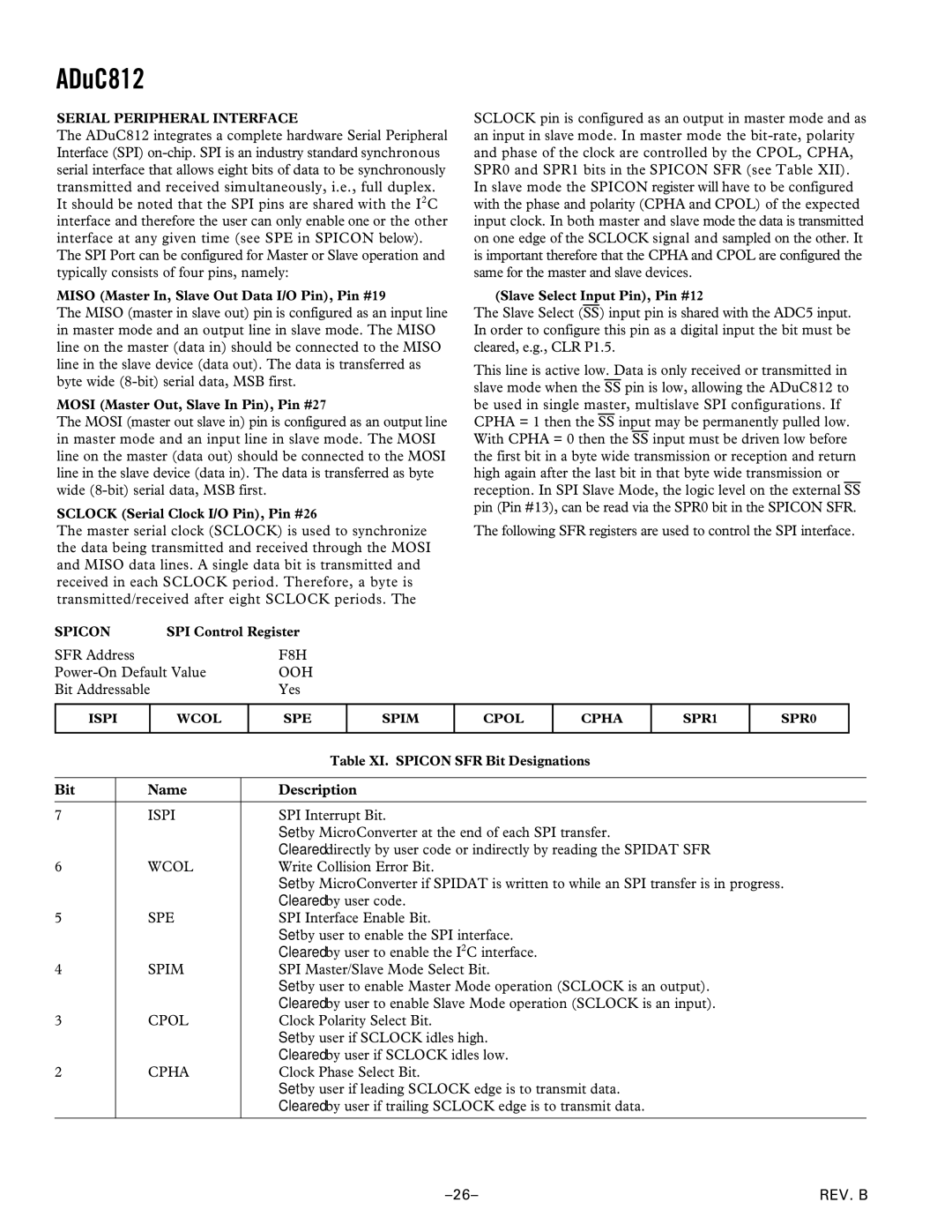ADuC812
SERIAL PERIPHERAL INTERFACE
The ADuC812 integrates a complete hardware Serial Peripheral Interface (SPI)
It should be noted that the SPI pins are shared with the I2C interface and therefore the user can only enable one or the other interface at any given time (see SPE in SPICON below). The SPI Port can be configured for Master or Slave operation and typically consists of four pins, namely:
MISO (Master In, Slave Out Data I/O Pin), Pin #19
The MISO (master in slave out) pin is configured as an input line in master mode and an output line in slave mode. The MISO line on the master (data in) should be connected to the MISO line in the slave device (data out). The data is transferred as byte wide
MOSI (Master Out, Slave In Pin), Pin #27
The MOSI (master out slave in) pin is configured as an output line in master mode and an input line in slave mode. The MOSI line on the master (data out) should be connected to the MOSI line in the slave device (data in). The data is transferred as byte wide
SCLOCK (Serial Clock I/O Pin), Pin #26
The master serial clock (SCLOCK) is used to synchronize the data being transmitted and received through the MOSI and MISO data lines. A single data bit is transmitted and received in each SCLOCK period. Therefore, a byte is transmitted/received after eight SCLOCK periods. The
SCLOCK pin is configured as an output in master mode and as an input in slave mode. In master mode the
SS(Slave Select Input Pin), Pin #12
The Slave Select (SS) input pin is shared with the ADC5 input. In order to configure this pin as a digital input the bit must be cleared, e.g., CLR P1.5.
This line is active low. Data is only received or transmitted in slave mode when the SS pin is low, allowing the ADuC812 to be used in single master, multislave SPI configurations. If CPHA = 1 then the SS input may be permanently pulled low. With CPHA = 0 then the SS input must be driven low before the first bit in a byte wide transmission or reception and return high again after the last bit in that byte wide transmission or reception. In SPI Slave Mode, the logic level on the external SS pin (Pin #13), can be read via the SPR0 bit in the SPICON SFR.
The following SFR registers are used to control the SPI interface.
SPICON | SPI Control Register | |
SFR Address |
| F8H |
OOH | ||
Bit Addressable |
| Yes |
ISPI
WCOL
SPE
SPIM
CPOL
CPHA
SPR1
SPR0
|
| Table XI. SPICON SFR Bit Designations |
|
|
|
Bit | Name | Description |
|
|
|
7 | ISPI | SPI Interrupt Bit. |
|
| Set by MicroConverter at the end of each SPI transfer. |
|
| Cleared directly by user code or indirectly by reading the SPIDAT SFR |
6 | WCOL | Write Collision Error Bit. |
|
| Set by MicroConverter if SPIDAT is written to while an SPI transfer is in progress. |
|
| Cleared by user code. |
5 | SPE | SPI Interface Enable Bit. |
|
| Set by user to enable the SPI interface. |
|
| Cleared by user to enable the I2C interface. |
4 | SPIM | SPI Master/Slave Mode Select Bit. |
|
| Set by user to enable Master Mode operation (SCLOCK is an output). |
|
| Cleared by user to enable Slave Mode operation (SCLOCK is an input). |
3 | CPOL | Clock Polarity Select Bit. |
|
| Set by user if SCLOCK idles high. |
|
| Cleared by user if SCLOCK idles low. |
2 | CPHA | Clock Phase Select Bit. |
|
| Set by user if leading SCLOCK edge is to transmit data. |
|
| Cleared by user if trailing SCLOCK edge is to transmit data. |
|
|
|
REV. B |
